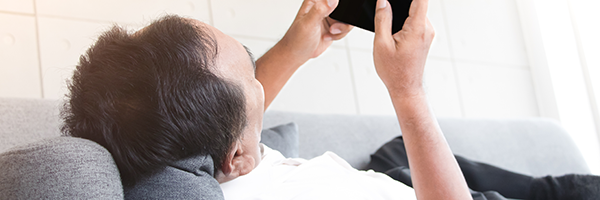
Take a moment to think about how you’re holding your body right now. This is posture: the way you sit, stand or even lie down. It actually has a lot to do with your bladder, bowel and pelvic health.
Let’s start at the pelvic floor. This is a layer of muscle that spans the bottom of the pelvis and supports the pelvic organs. Well-functioning pelvic floor muscles help with bladder and bowel control.
However, these muscles don’t function alone. To help maintain continence, the pelvic floor works together with other core muscle groups like the diaphragm, abdominals, and spinal muscles.
Pelvic health physiotherapist Annabelle Citroen explains how these are linked to posture.
“Poor posture can lead to imbalances in any one of these core muscle groups. When this happens, there is potential for more pressure on the pelvic floor muscles, and this can then impact bladder and bowel control,” Annabelle says.
Symptoms of pelvic pain and tightness can also be linked to posture. Annabelle says that sitting in a slouched position increases pressure through the coccyx (tailbone) and can lead to pain if it is for a long time.
“As tempting as it may be on a cold winter’s day, sitting with legs outstretched on the bed is a sure way to encourage this slouched posture.”
On the other hand, going too far in the other direction isn’t ideal. Very upright and unsupported sitting positions have been associated with higher levels of activity in the pelvic floor muscles. Over time, this could potentially lead to tightness or pain in the pelvic region.
If isolation has made you glued to the couch or you’ve been working at home, check out Annabelle Citroen’s tips for the optimal sitting position.
- A supported sitting position (on a chair with a back rest) is best if you are sitting for long periods of time. While sitting on a fitball will challenge some of your central ‘core’ muscles to work a bit harder, you’re highly likely to become distracted by a task and ‘fall’ into poorer postures.
- Sit on a padded surface. A hard surface may lead to some extra pressure and discomfort on the bony structures at the base of your pelvis.
- Sit with your buttocks right at the back of the seat, allowing the back rest to support your spine. Our lower spine should maintain a small inward curve. You may need to place a lumbar support such as a small cushion or rolled towel to help you keep this posture.
- Sit with your weight evenly balanced between your sitting bones. Avoid crossing your legs.
- Your feet should sit supported on the ground (or a small foot stool if you need), aiming for the hips to rest at a 90-degree angle.
- Imagine a puppet string attached to the top of your head, gently pulling upward and tucking your chin in slightly.

Follow the tips above, but also remember that our bodies are doing all sorts of magical things behind the scenes.
“Our bodies are typically quite clever in adjusting to changes in position and activities, activating different groups of muscles to support us through a wide range of movements,” Annabelle says.
You can help it by checking that your workstation set-up allows you to sit optimally. Get up and move every hour for a few minutes and include stretches for the muscles around the hips and spine.
This story was first published in Bridge magazine. Subscribe to Bridge online.

